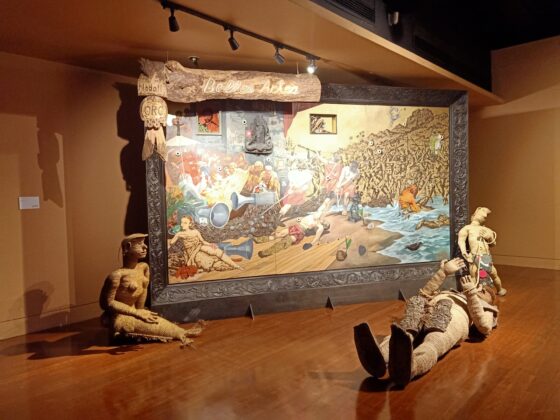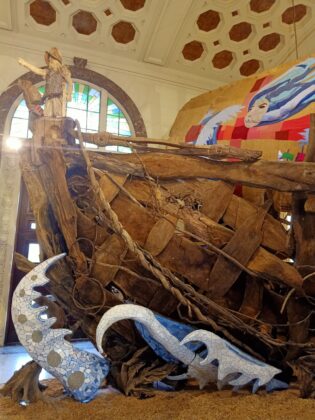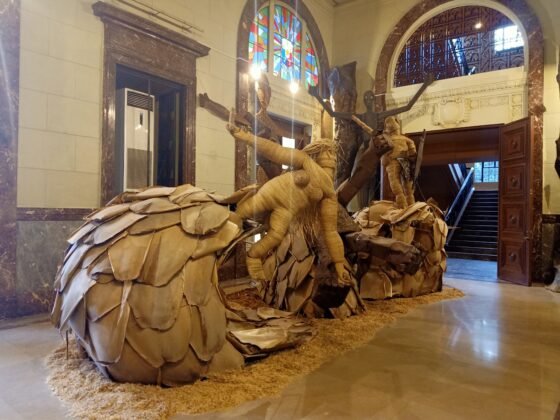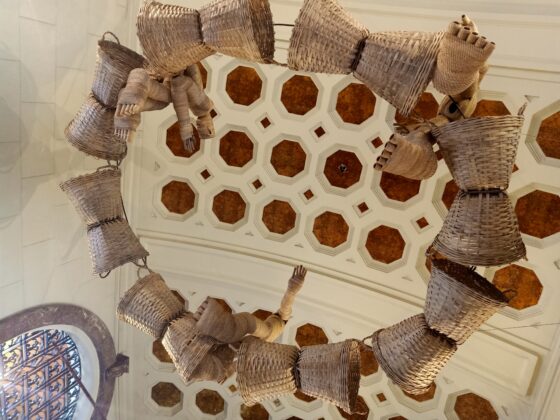Kidlat Tahimik focuses on the Filipino’s ‘indio-genius’
1 of 4 SOME of the art installations in the exhibit ‘INDIO-GENIUS: 500 Taon ng Labanang Kultural (1521-2021)’ by Kidlat Tahimik — PHOTO BY MICHELLE ANNE P. SOLIMAN PHOTO BY MICHELLE ANNE P. SOLIMAN PHOTO BY MICHELLE ANNE P. SOLIMAN PHOTO BY...
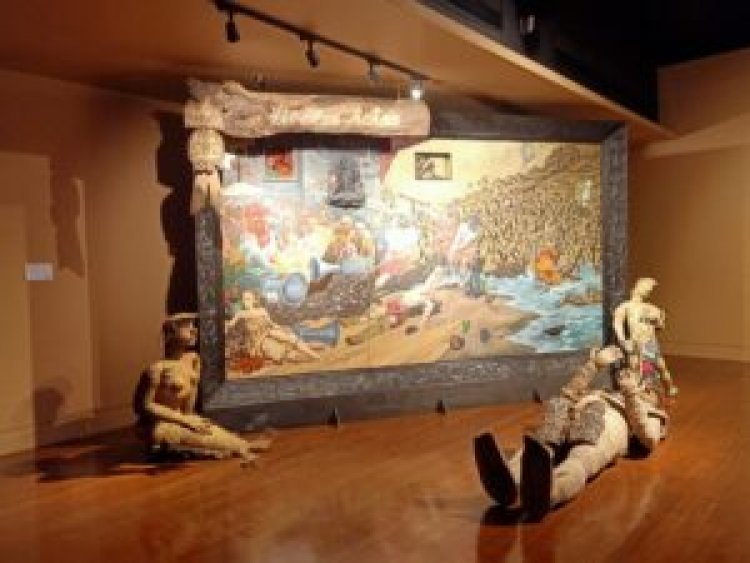
A GIANT driftwood ship fills a hall of the National Museum of Anthropology, ceramic mosaic “waves” crashing along its sides. It is a version of the Victoria, the only ship to make it back to Spain from Magellan’s expedition of exploration, and is part of a major exhibition by National Artist for Film and Broadcast Arts Eric Oteyza de Guia — better known as Kidlat Tahimik — in which he explores colonialism in Philippine history and what he calls the Filipinos’ “indio-genius.”
This is actually a homecoming for the exhibit, which was originally shown in Madrid’s Palacio de Cristal del Retiro from October 2021 to March 2022. It will now be on view at the National Museum of Anthropology in Manila for the next six months. In Spain it was called “Magellan, Marilyn, Mickey and Fray Damaso: 500 Years of Rock Star Conquerors”. Its new title in Manila is “INDIO-GENIUS: 500 Taon ng Labanang Kultural (1521-2021)”.
“This is one of the most important things we have ever staged,” said National Museum Director-General Jeremy R. Barns during a media preview of the exhibition on Oct. 18. “This is one of those things that goes to try to answer, ‘What do Filipinos know about being Filipino?’, and ‘What’s our identity?’”
Unlike the display in Madrid’s Palacio de Cristal del Retiro where the large-scale artworks were all found in one space, the large-scale installations and sculptures are scattered in three main spaces at the National Museum of Anthropology.
INDIO-GENIUS
The term “indi-genius” was coined by Mr. Tahimik’s Ifugao mentor, Lopes Na-Uyac, referring to the innate brilliance of the Filipino people, especially the indigenous communities.
The 80-year-old National Artist said that his mentor would always mispronounce the word “indigenous” — a mispronunciation which the former found fascinating.
“He combined the word ‘genius’ and ‘indigenous’ into one word, which says it all — there’s still a lot of genius sa kaalaman ng katutubo (in the knowledge of the natives) especially when it comes to harmony with nature,” Mr. Tahimik said during a guided tour of the show. He later changed the term slightly into “indio-genius.”
Indio was a term used by colonizers (often in ridicule) to refer to locals. “But in spite of being indio-nized, the genius of our indigenous culture still survives,” he said, “That’s why I’m doing a show like this.”
The artist used organic materials, such as wood from trees that had fallen due to typhoons, found objects, rocks and stones, shells, and dried palm leaves to create his installations.
“I am a National Artist for Film… But it is something that I’m trying to break out of the box from… I think I’m much more all around,” he said.
The large-scale installation begins with the Mad Expo 1887 display at the ground floor staircase in front of the Museum’s entrance. The installation is a reference to the Madrid Expo of 1887 by the Spanish Ministry of Overseas Colonies where imported flora and fauna — and Igorots — were exhibited. This incident made the future National Hero Jose Rizal protest in a letter to Ferdinand Blumentritt: “How dare they treat Ygorrotes like a human zoo?” In this section, Mr. Tahimik added a wooden sculpture of a two-faced Rizal — portraying him as a writer, and as a filmmaker.
At the balcony of the Marble Hall is the large installation Ang Ma-bagyong Sabungan ng 2 Bathala ng Hangin, A Stormy Clash Between 2 Goddesses of the Winds (WW III — the Protracted Kultur War). It features a Trojan Horse with a Hollywood film camera for its head, surrounded by pop culture figures such as Spider-man, Marilyn Monroe, and Mickey Mouse, both clashing and being guarded by the bulul or rice deities of the Ifugao people.
Inside the Marble Hall the Victoria, the only ship to complete the Spanish expedition in 1522. Standing on the ship is a wooden sculpture of the Portuguese captain and navigator Ferdinand Magellan and his Malay servant Enrique de Malacca. The latter successfully completed the circumnavigation of the world — he brought along from the expedition’s start in Spain, and was one of only a few of the original men who returned to Spain alive. He is known to have been able to converse with people in Limasawa (in what is now Southern Leyte in the Philippines) when the expedition anchored off the island.
“I look at Mactan as a cultural battle besides. [Battle] is usually about body count or how many missiles were launched. Very few people look at the cultural clashes involved in a battle,” the artist said of the place where Magellan met his end at the hands of the men of local chieftain Lapu Lapu.
The final stretch of the exhibition is located at the Museum’s Gallery 1. It includes sculptures by the artist’s wife Katrin, and their sons. His namesake and late son, Kidlat, created a photograph tapestry titled Saan galing ang Indio-Genuis ni Jose Rizal? Also on view are works by his other sons, Kawayan and Kabunyan. Kawayan’s work is a mixed media painting titled Homage to Juan Luna’s Spoliarium, and Kabunyan’s is a framed Philippine map made of ceramic tiles, laminated flooring, iron balusters, and carved wood.
“At that time, all our young expats were fighting for reclamation in Madrid. They were fighting arrogance and racism of the colonialists. In a way they were proving themselves,” Mr. Tahimik said of Rizal and the other Illustrados in Spain.
“Rizal being a genius is not because he is westernized,” he said; the idea would rather be: “’Kung kayang kaya niyang pasukan yung mga [If Rizal can get into] western accomplishments like that… [it’s because of his Indio-Genius talents from his local culture.”
“INDIO-GENIUS: 500 Taon ng Labanang Kultural (1521-2021)” is on view at the National Museum of Anthropology, Luneta Park, Manila. Walk-in visitors are accepted while advance booking through https://reservation.nationalmuseum.gov.ph/ is required for groups of 20 to 30 persons. The museum is open on Tuesdays to Sundays, from 9 a.m. to 6 p.m. For more information, visit https://www.facebook.com/nationalmuseumofthephilippines/. — Michelle Anne P. Soliman


